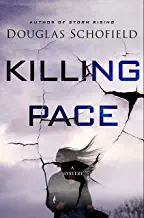Killing Pace by Douglas Schofield
When it comes to writing good mystery crime novels, Douglas Schofield has a wealth of experience to fall back on. Having worked as a trial lawyer for over 30 years, he has seen hundreds of crimes go through the court room, prosecuting and defending them himself. For the past few years, however, he’s been bringing us some of the best, high-stakes mystery novels, with Storm Rising, and Time of Departure, to name a few. But now, with his latest book Killing Pace, he’s introducing a whole new series.
When Lisa Green crawls out of the wreck of a horrific accident, she’s stunned to find that she’s lost all of her memories. Lisa has no idea who she is, or where she was going, no matter how hard she tries to remember while she’s very carefully nursed back to health by Roland, her boyfriend – except every instinct Lisa has is telling her that not only is she not his girlfriend, she’s a prisoner, and that something is very wrong. With escape as her only option for survival, she finds out that she wasn’t randomly chosen, and that there is so much more to this than just a twisted kidnapping.
Author Douglas Schofield talks about his latest book in an exclusive Q&A with BookTrib.
BookTrib: You were a trial lawyer for over thirty years, and prosecuted or defended hundreds of cases, dealing with some of the worst crimes. How much of your work in law has influenced the material of your writing?
Douglas Schofield: Decades of observing the discordant, at times sordid, and often vicious realities of life through the formalized prism of legal proceedings has certainly supplied me with plenty of raw material. And I’m also well aware of that old platitude, “write what you know.” But wanted to go bigger than the staged drama of a courtroom. I have always objected to the idea, promoted by well-meaning friends, that because I’m a lawyer, my lead character should be a lawyer. And, not just a lawyer, but a male lawyer. Why male? What about a quick-thinking legal secretary who stumbles on a terrorist financing plot? Meet Grace Palliser in Flight Risks. Why not a sure-handed emergency room surgeon abducted by a billionaire media tycoon? Meet Dr. Emma Parks in Succession. Or, a whip-smart school teacher who teams up with a Mafia Don to investigate her cop husband’s murder? That was Lucy Hendricks in Storm Rising. Okay, I admit that in Time of Departure, Claire Talbot was a Florida State Attorney on the trail of serial killer— but in Killing Pace, my most recent novel, our heroine is . . . um . . . maybe I’d shouldn’t give too much away.
So, yes, all those years spent prosecuting and defending violent criminals, drug traffickers, swindlers, and assorted thieves informed my writing. But I’d have to say that their main contribution has been my long-running education in law enforcement—its techniques, its vulnerabilities, its habits of mind—and in the unforgiving realities of life on the dark side.
BookTrib: The way you write the details and settings in Killing Pace is so vivid and powerfully realistic that it feels like you’re in the room with the characters. Did you research everything beforehand, and if so, how do you translate that to the page?
DS: Research is an ongoing process, and one that I enjoy. I’m not talking about poring through textbooks and online resources to make sure I’ve got some underlying fact straight. After a long legal career, such activity has become second nature. No, the real excitement for me comes with the on-site visits. If you search my name on www.criminalelement.com, you will find my blog series, “Adventures in Research.” There I talk about the research trips my wife, Melody, and I have taken to the various locations in my novels, and I relate some of the many surprising adventures we’ve had along the way. In preparation for Killing Pace, we spent days combing the backroads of Big Cypress National Reserve in south Florida, wandering through Everglades City, interviewing National Park Service officers, supermarket managers, and motel owners, and taking hundreds of photographs. We repeated the whole process in Sicily, Italy, where an earlier research trip (focused on several scenes in Storm Rising) had introduced us to a phalanx of willing and immensely helpful Sicilians from every walk of life. One of them, a professor of geology, gave us a tour of an underground salt mine—a location so compelling that I decided on the spot that I would set a pivotal scene in Killing Pace within its dank underworld precincts.
As for translating these scenes and experiences to the written page, that is a process more difficult to explain. The fact that I have walked the same streets as my characters, inhaled the same air, or sat in the same rooms (or, in one case, the same stone culvert used by my heroine as an observation point), benefits the writing process immensely. I sit at my desk, surrounded by all those photographs, call up those memories, and . . . start writing.
BookTrib: One of the things I find really interesting in books is the perspective of the character in relation to the author. Lisa/Laura is such a fantastic character; she’s smart, she’s tough, and throughout it all, she’s relatable. But she’s also different from the other female characters you’ve created, like Lucy Hendricks in Storm Rising. Did you find it hard writing from a female perspective, and creating female characters that aren’t typecast?
DS: Your question reminded me that GAME OF THRONES author George R. R. Martin was once asked during an interview how he writes women so well. I loved his reply: “You know, I’ve always considered women to be people.”
I should start by saying that writing from a female perspective wasn’t as difficult as I thought it would be. Partly that was because—as Mr. Martin pointed out so pithily—women and men are simply human, and we share the same hopes, fears, desires, vulnerabilities, and flaws. And partly it was because I didn’t complete my first novel until I was almost twenty years into my legal career. During those years, I had come to know—both socially and professionally—many utterly remarkable women. Over those years, as well, I had come to recognize something that has probably been obvious to women readers since the dawn of commercial fiction. Please permit me a short quote from my article, “Why I Write Women,” which was published last year on www.criminalelement.com:
“Years ago, when I noticed that in commercial fiction—particularly in the mystery/suspense/thriller arena—women were being routinely assigned to the supporting roles, I asked myself: “Why is so much of this fiction devoted to hard-bitten male characters—cynical detectives trailing a string of divorces, or highly-trained killing machines?”
Why not a formidable woman?
So . . . I went with it. I decided to create “smart, tough, and relatable” female characters. And I wanted to make damned sure they weren’t “typecast.” I think I’ve succeeded. I hope I’ve succeeded, because the time for these heroines is long past.
Of course I don’t pretend to comprehend every unique aspect of the female experience. But I do have access to “special consultants” – primary among them, of course, is my wife Melody—a formidable woman in her own right. I also have a couple of close female friends. In return for my solemn promise that they shall remain forever anonymous, they have provided me with intimate, detailed, and often eloquent disclosures about their X-chromosome lives.
These women are my heroines.
Booktrib: Now, an element of this book that you brought in was the Syrian refugee crisis, which of course relates to the migrant crises in general. But specifically, you detailed how the criminal underworld profits off of this displacement and suffering. Can you talk to us about that, and where you see the migrant and refugee crises going in the future?
DS: Please study this photograph:
 That heartbreaking image appeared in the September 3, 2017, edition of the The Independent. The accompanying article included this paragraph:
That heartbreaking image appeared in the September 3, 2017, edition of the The Independent. The accompanying article included this paragraph:
“Over the past five years, 9,287 children have sought safety in the UK as ‘unaccompanied minor’ asylum seekers travelling alone, without a parent or guardian. Many of the children are fleeing war, poverty and persecution in their home countries. During this period, 360 have gone missing and are still unaccounted for. Of these, 81 of the children have been missing for five years, a further 77 children have been missing for four years and another 87 children have been missing for three.”
Those are just the figures for the U.K. The number of missing refugee children in the entire European Union exceeds 10,000—and that number only includes children who were documented on first arrival and have since vanished.
Ten thousand missing children. How can such a statistic be ignored?
Mostly, it is ignored. And, in the current international climate of nativism, intolerance and xenophobia—where even some EU member states have defied the Union’s mandatory quotas and accepted no (that is, zero) refugees—it will probably continue to be ignored. Meanwhile, in northern Africa, the Middle East, and Europe, criminal gangs are preying on this “human flow” at every stage. They are profiting from extortion, from forced labor, from sex trafficking, and even from selling the organs of dead (read: “murdered”) refugees.
Were all this not enough—and this brings us to Killing Pace—more than 50,000 babies have been born in refugee camps in Lebanon, Jordan, Turkey, and across southern Europe. These children are growing up as stateless persons, and they run a very high risk of being sold or abducted for sexual exploitation, child labor, or illegal adoption. I was already aware of the baby laundering scandals of the past—from Central America, from Cambodia, from Somalia—and I couldn’t turn my back on that.
Neither could Laura Pace.
BookTrib: There’s that phrase that goes “write what you want to read.” Have you read anything that you wish you had written?
DS: A confession: I don’t read much fiction. I’m a history buff, and I tend to read a lot of history and biography (right now I’m reading Levi Roach’s Longman-History Today Prize-winning biography of the Anglo-Saxon king, Aethelred the Unready).
However, that said, I have always admired Douglas Preston and Lincoln Child for their unique creation, FBI agent Aloysius Pendergast. Of that series, I can definitely say that I wish I had written The Cabinet of Curiosities.
Killing Pace is now available for purchase. For more information on the author, please visit his website DouglasSchofield.com, or his Facebook.
Buy this Book!
Amazon




